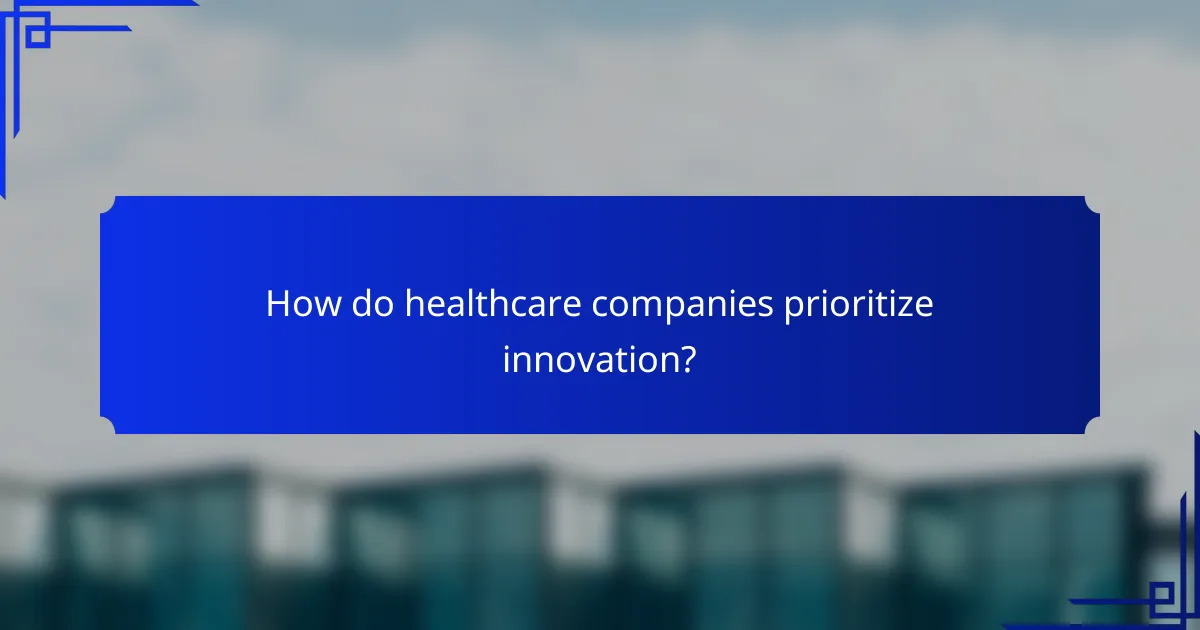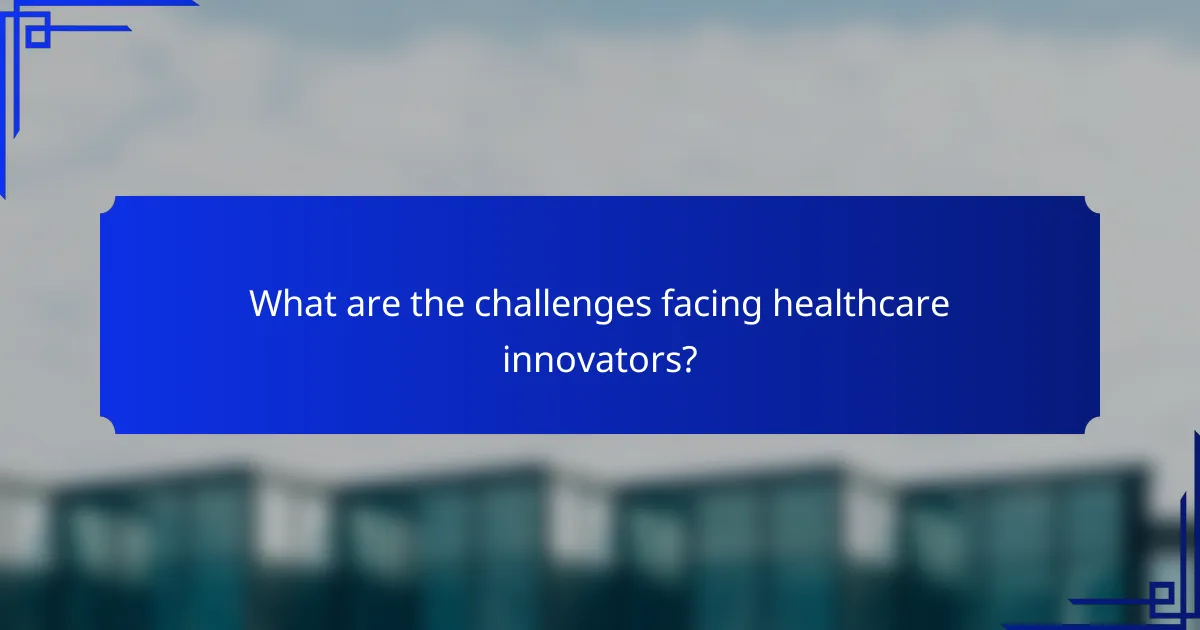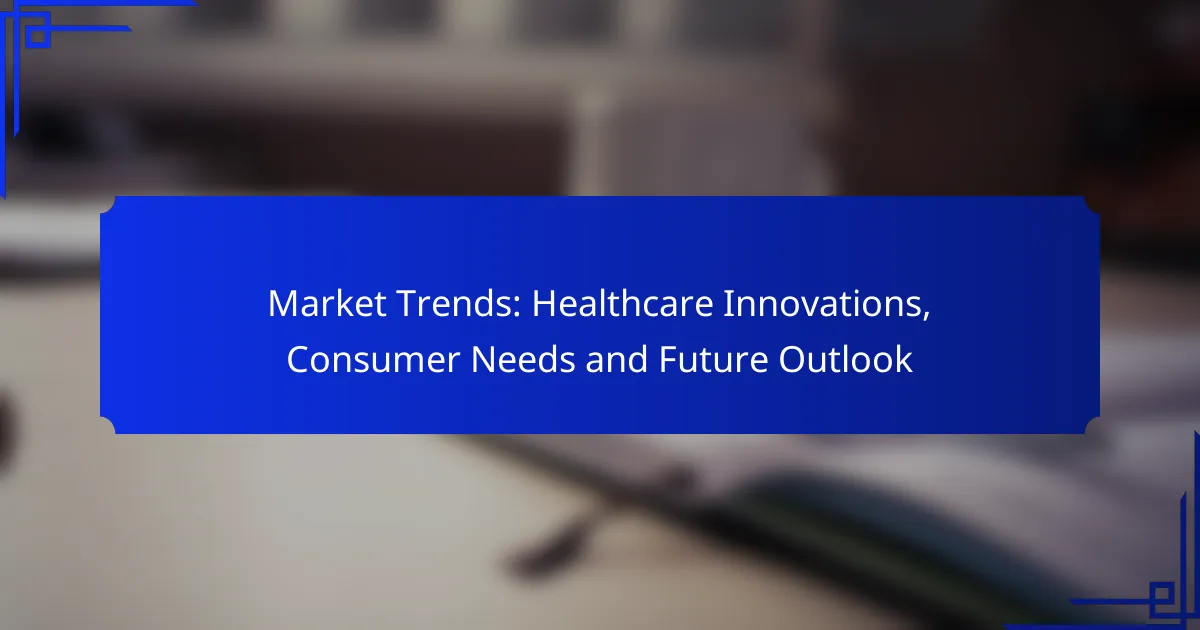The healthcare landscape is rapidly evolving, driven by innovations aimed at enhancing patient care and accessibility through technology. With a focus on telehealth, wearable devices, and artificial intelligence, the industry is responding to the growing consumer demand for personalized services and mental health support. As regulatory changes and technological advancements continue to shape the market, healthcare providers must adapt to meet the changing expectations of informed and engaged patients.

What are the latest healthcare innovations in the US?
The latest healthcare innovations in the US focus on enhancing patient care, improving accessibility, and leveraging technology for better outcomes. Key areas include telehealth, wearable technology, artificial intelligence in diagnostics, and blockchain for secure patient data management.
Telehealth advancements
Telehealth has rapidly evolved, providing remote healthcare services through digital platforms. Patients can now consult healthcare providers via video calls, reducing the need for in-person visits and improving access to care, especially in rural areas.
Key advancements include improved video conferencing tools and integrated health monitoring systems. These technologies enable real-time health assessments and follow-ups, making healthcare more efficient and responsive to patient needs.
Wearable health technology
Wearable health technology, such as fitness trackers and smartwatches, has gained popularity for monitoring various health metrics. These devices can track heart rate, sleep patterns, and physical activity, empowering users to take charge of their health.
Many wearables now integrate with health apps, allowing users to share data with healthcare providers. This connectivity can lead to personalized health recommendations and proactive management of chronic conditions.
AI in diagnostics
Artificial intelligence is transforming diagnostics by analyzing medical data more accurately and quickly than traditional methods. AI algorithms can detect patterns in imaging studies, lab results, and patient histories, leading to earlier and more accurate diagnoses.
For example, AI tools are increasingly used in radiology to identify abnormalities in X-rays and MRIs, often achieving higher accuracy rates than human radiologists. This technology not only enhances diagnostic precision but also reduces the workload on healthcare professionals.
Blockchain for patient data
Blockchain technology is being explored for its potential to secure patient data and enhance interoperability among healthcare systems. By creating a decentralized ledger, blockchain can ensure that patient records are tamper-proof and easily accessible to authorized users.
This innovation addresses concerns about data breaches and privacy, as patients can control who accesses their information. As regulations evolve, blockchain could become a standard for managing sensitive health data securely and transparently.

How are consumer needs shaping healthcare trends?
Consumer needs are increasingly driving healthcare trends, emphasizing the importance of tailored services, mental health support, and digital solutions. As patients become more informed and engaged, healthcare providers must adapt to meet these evolving expectations.
Increased demand for personalized medicine
The shift towards personalized medicine reflects consumers’ desire for treatments tailored to their unique genetic profiles and health histories. This approach allows for more effective therapies and minimizes adverse effects, making it a priority for many healthcare providers.
Examples include targeted therapies for cancer that consider specific genetic mutations. Patients can expect a growing range of options that cater to their individual needs, enhancing treatment efficacy and satisfaction.
Focus on mental health services
There is a notable increase in the demand for mental health services, driven by greater awareness of mental health issues and the stigma reduction surrounding them. Consumers are seeking accessible, effective care options that address a variety of mental health conditions.
Healthcare providers are responding by expanding services, offering teletherapy, and integrating mental health into primary care. This holistic approach not only improves patient outcomes but also ensures that mental health is prioritized alongside physical health.
Preference for digital health solutions
Consumers are increasingly favoring digital health solutions, such as telemedicine and health apps, for their convenience and accessibility. These tools allow patients to manage their health from home, reducing the need for in-person visits and streamlining communication with healthcare providers.
Healthcare organizations are investing in technology to enhance patient engagement and improve care delivery. For instance, mobile health applications can track symptoms, schedule appointments, and provide educational resources, making healthcare more user-friendly and efficient.

What are the key factors driving healthcare innovation?
Key factors driving healthcare innovation include regulatory changes, technological advancements, and evolving consumer expectations. These elements collectively shape the landscape of healthcare, influencing how services are delivered and received.
Regulatory changes
Regulatory changes play a crucial role in healthcare innovation by establishing frameworks that encourage or restrict new developments. For instance, updated policies may streamline the approval process for medical devices or pharmaceuticals, allowing innovations to reach the market faster.
Healthcare providers must stay informed about regulations such as the Health Insurance Portability and Accountability Act (HIPAA) in the U.S. or the General Data Protection Regulation (GDPR) in Europe, as these can impact data management and patient privacy. Compliance with these regulations is essential to avoid penalties and ensure patient trust.
Technological advancements
Technological advancements are at the forefront of healthcare innovation, enabling new treatments and improving patient care. Innovations such as telemedicine, artificial intelligence, and wearable health devices are transforming how healthcare is delivered, making it more accessible and efficient.
For example, telehealth services have surged in popularity, allowing patients to consult with healthcare providers remotely. This shift not only enhances convenience but also expands access to care for individuals in rural or underserved areas.
Consumer expectations
Consumer expectations are evolving, with patients increasingly demanding personalized, convenient, and transparent healthcare experiences. As consumers become more informed, they seek services that prioritize their needs and preferences, pushing healthcare providers to innovate continuously.
Healthcare organizations can meet these expectations by implementing user-friendly platforms for appointment scheduling, providing clear pricing information, and offering personalized treatment plans. Failing to adapt to these consumer demands may result in decreased patient satisfaction and loyalty.

How do healthcare companies prioritize innovation?
Healthcare companies prioritize innovation by focusing on research and development, collaboration with technology firms, and understanding consumer needs. These strategies help them stay competitive and meet the evolving demands of patients and providers.
Investment in R&D
Investment in research and development (R&D) is crucial for healthcare companies aiming to innovate. These firms typically allocate a significant portion of their budgets—often ranging from 10% to 20%—to R&D to develop new treatments, technologies, and processes.
Prioritizing R&D allows companies to explore cutting-edge solutions, such as personalized medicine or telehealth services. However, they must balance this investment with operational costs and regulatory compliance to ensure sustainable growth.
Collaboration with tech firms
Collaboration with technology firms is increasingly important for healthcare companies looking to enhance their innovation strategies. By partnering with tech companies, healthcare providers can leverage advanced technologies like artificial intelligence and data analytics to improve patient care and operational efficiency.
These partnerships can take various forms, including joint ventures, strategic alliances, or technology licensing agreements. Successful collaborations often focus on shared goals, such as developing digital health platforms or improving patient engagement tools, which can lead to better outcomes and increased market competitiveness.

What are the challenges facing healthcare innovators?
Healthcare innovators face several significant challenges, including data privacy concerns and the integration of new technologies into existing systems. These obstacles can hinder the adoption of innovative solutions and impact overall effectiveness in the healthcare sector.
Data privacy concerns
Data privacy is a critical issue for healthcare innovators, as they must navigate strict regulations like HIPAA in the United States or GDPR in Europe. Ensuring patient data is protected while still allowing for effective innovation is a delicate balance.
Innovators should implement robust security measures, such as encryption and access controls, to safeguard sensitive information. Regular audits and compliance checks can help identify vulnerabilities and maintain trust with consumers.
Integration of new technologies
Integrating new technologies into existing healthcare systems can be complex and resource-intensive. Innovators must consider compatibility with current infrastructure and the potential disruption to workflows during the transition.
To facilitate smoother integration, healthcare organizations should invest in training staff and developing clear implementation plans. Collaborating with technology providers can also help ensure that new solutions align with operational needs and regulatory requirements.
